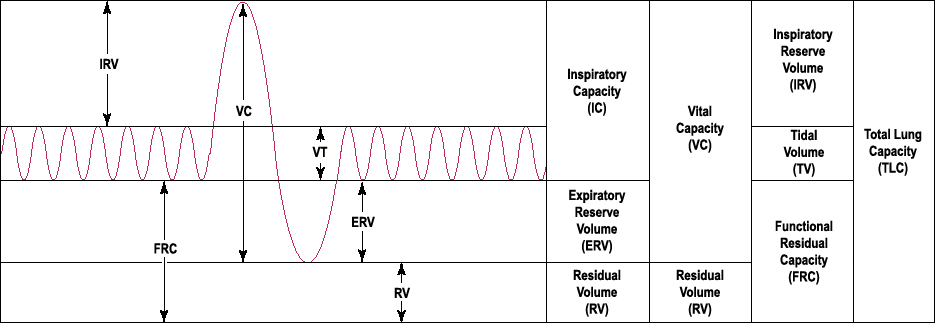The average total lung capacity of an adult human male is about 6 litres of air, but only a small amount of this capacity is used during normal breathing.
The breathing mechanism is called respiration. Tidal breathing is normal, resting breathing; the tidal volume is the volume of air that is inhaled or exhaled in a single such breath. It's 0.5 litres
Average lung volumes in healthy adults | ||
Volume | Men (Value-litres) | Women(Value-litres) |
Inspiratory reserve volume | 3.3 | 1.9 |
Tidal volume | 0.5 | 0.5 |
Expiratory reserve volume | 1.0 | 0.7 |
Residual volume | 1.2 | 1.1 |
| Volume | Men | Women | Derivation /td> |
| Vital capacity | 4.8 | 3.1 | IRV+TV+ERV |
| Inspiratory capacity | 3.8 | 2.4 | IRV+TV |
| Functional residual capacity | 2.2 | 1.8 | ERV+RV |
| Total lung capacity | 6.0 | 4.2 | IRV+TV+ERV+RV |

An average human breathes some 12-20 times per minute.
Several factors affect lung volumes; some can be controlled and some cannot. Lung volumes can be measured using the following terms:
| Larger volumes | Smaller volumes |
| taller people | shorter people |
| non-smokers | smokers |
people who live at higher altitudes | people who live at lower altitudes |
When someone living at or near sea level travels to locations at high altitudes (eg. the Andes, Tibet, the Himalayas, etc.) that person can develop a condition called altitude sickness because their lungs remove adequate amounts of carbon dioxide but they do not take in enough oxygen. (In normal individuals, carbon dioxide is the primary determinant of respiratory drive.)

No hay comentarios:
Publicar un comentario